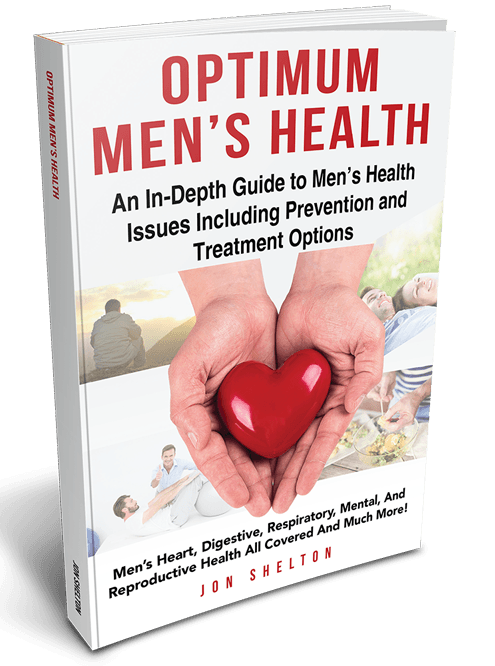CHAPTERS
Navigate to chapter
► Chapter One: Understanding the Top Men’s Health Issues
► Chapter Two: Men’s Heart Health
► Chapter Three: Men’s Digestive Health
► Chapter Four: Men’s Respiratory Health
► Chapter Five: Men’s Mental Health
► Chapter Six: Men’s Reproductive Health
► Chapter Seven: Other Health Issues
► Chapter Eight: Nutrition and Exercise
► Chapter Nine: Frequently Asked Questions
Chapter One: Understanding the Top Men’s Health Issues

If you hate going to the doctor, you are not alone – many men neglect their annual checkup, not realizing that it could have a serious impact on their health. In this chapter you will learn about the importance of an annual physical and you will receive an introduction to some of the most common men’s health issues. The information in this chapter will serve as an introduction for the rest of the book in which these issues will be discussed in depth.
If you were to open up a conversation about the differences between men and women, there are certain topics that you would likely discuss. You might mention things like the wage gap, or the average age of puberty – you might even talk about general health and hygiene habits. These kinds of differences between the two sexes are quantifiable and they are worthy of discussion. When it comes to the differences between men and women, however, these may not be the biggest differences that should be given attention.
Many men do not realize that there are some significant differences between men and women when it comes to issues related to health and longevity. If you do just a little bit of research, however, you will come across some shocking statistics such as the following:
- Men are 24% less likely than women to have visited their doctor within the past 12 months.
- Men are 22% more likely than women to have neglected routine cholesterol tests.
- Men have a 28% higher risk for being hospitalized for congestive heart failure and 32% more likely to be hospitalized for the long-term complications of diabetes.
- Men are twice as likely as women to have a leg or foot amputated due to complications of diabetes.
- Men are 24% more likely than women to be hospitalized for pneumonia that could have easily been prevented by getting a vaccination.
What you may notice if you take the time to carefully review this list of statistics, is that many of the problems mentioned are easily preventable. You may notice a theme – that men tend to be more likely than women to neglect simple health checks or vaccinations which could prevent a serious health problem from occurring later on down the road. This may not be true for all men, but it certainly does seem to be a common issue.
According to the Social Security Administration, men who reach the age of 65 can be expected to live an average of 2.3 years less than women who reach the age of 65. A study of human life expectancy during the last decade of the 20th century taken by Bertrand Desjardins, a researcher at the University of Montreal, notes that U.S. male life expectancy was an average of 6.7 years shorter on the whole. Desjardins also notes that the mortality of males is higher than that of females from the very beginning of their lives – as much as 25% to 30% higher!
But what exactly should you take away from these statistics? These statistics may be saddening – scary, even – but they may be just the kind of reality check you need to start taking your own health and wellness more seriously. As a man, you are already disadvantaged in terms of life expectancy and mortality – don’t you want to do what you can to reduce your health risks and to live the longest, healthiest life you can?
If you are serious about taking your health more seriously, it all starts with a visit to your primary care physician. A yearly checkup or annual physical is a must for both men and women. During this checkup your doctor will make note of certain things like your height, weight, and body mass index (BMI) – he may also order various tests or health screenings. The information gathered from these tests will help your doctor to determine whether you have any health problems that need to be addressed.
Many men neglect to schedule annual physicals when they are not feeling physically ill. You must realize, however, that preventive care is extremely important – catching a disease in the early stages could drastically improve your chances of making a full recovery. Furthermore, keeping up to date with your immunizations could completely protect you from certain illnesses which have the potential to be very serious. An annual physical takes just a few minutes to schedule an generally no more than an hour to complete – isn’t your health worth an hour of your time?
If you can’t be convinced to schedule an annual physical each year, here is a list of reasons that may indicate the need for a checkup:
- You are sick or have been exposed to some kind of illness.
- You are displaying symptoms of an illness or have experienced changes that concern you.
- You have a chronic or ongoing condition that needs to be managed.
- You want to check in about side effects and dosage for any medication you may be taking.
- You have certain bad habits that could affect your health such as drinking, smoking, or overeating.
- You have a family history of certain diseases, especially serious diseases.
These reasons are all valid when it comes to motivation for scheduling an annual physical. If you can’t be convinced by the potential benefits of preventive care for your own health, think about the benefits it could have for your wallet. If you have health insurance, the cost of your annual exam is probably completely covered except for any applicable copay. The cost of ignoring a potential problem, however, could be very high – you may end up going to the emergency room for treatment and, if the condition is allowed to progress, you may even need to be hospitalized. Medical expenses add up quickly and, in many cases, they can be prevented by catching a problem early during a simple yearly checkup.
By now the benefits of an annual checkup should be obvious to you. In the next section you will receive an overview of common men’s health issues that your doctor may look for during your annual exam. You will also receive a list of recommended health screenings for men determined by age.
2.) What are the Most Common Men’s Health Issues?
Many men think that they are invincible – as long as they feel okay for the most part, they do not see any reason to go to the doctor, even for an annual checkup. What many of these men do not realize is that serious health problems can be lurking just beneath the surface and you may not experience any outward symptoms until the disease has progressed. Some of the most dangerous silent killers include various types of cancer and heart disease. In this section you will find an overview of some of the most common men’s health issues.
- Heart Disease – According to the Centers for Disease Control (CDC), one in four men has some form of heart disease– furthermore, heart disease is the number one killer of both men and women. In fact, heart disease can begin to manifest 10 years earlier in men than women.
- Stroke – The third most common cause of deathin the United States, stroke affects more than 3 million men each year. High blood pressure is extremely common in men under the age of 45 and it greatly increases your risk for stroke.
- Cancer – In all of its many forms, cancer is the second leading cause of deathin the United States. Lung cancer is the most common type of cancer, taking more lives than colon, prostate, and breast cancers combined. In men, the most common form of cancer is prostate cancer and it is the second leading type of cancer death in men, after lung cancer.
- Depression/Suicide – According to the National Institute of Mental Health (NIMH), more than 6 million men suffer from depressioneach year. It is also worth noting that men are four times as likely as women to commit suicide. The NIMH also notes that this may be partially due to the fact that depression is largely underdiagnosed in men as compared to women.
- Respiratory Disease – Emphysema, COPD, and lung cancer(among other forms of respiratory disease) can easily become life-threatening. According to the American Lung Association, each year more men are diagnosed with lung cancer than in the previous year.
- Alcoholism – The Centers for Disease Control suggest that men tend to binge drink twice as much as womenand they face much higher rates of alcohol-related deaths and hospitalizations as well. Excessive alcohol consumption increases the risk for various cancers and it can interfere with hormone production and testicular function.
- Accidents/Injuries – Not only are men more likely than womento skip their annual checkups, but they are also more likely to put themselves in potentially dangerous situations. The CDC notes that motor vehicle death rates were twice as high for male drivers and passengers than for females. In fact, unintentional injury was the leading cause of death for men in 2006.
- Liver Disease – The liver is responsible for ridding the bodyof toxic substances and its function can be impaired by a number of serious diseases such as cirrhosis, viral hepatitis, liver cancer, or alcoholic liver disease. Alcohol and tobacco use can increase your risk for developing liver disease.
Diabetes – You may not think of diabetes as a life-threatening disease, but it can become very dangerous if neglected or if not properly managed. Untreated diabetes often leads to nerve and kidney damage as well as vision problems and an increased risk for heart attack and stroke.
Continue Reading…
Want to read the entire thing?

